Ford has waved goodbye to hatchbacks and stocked its range with SUVs.
That means there are plenty of tempting, high-riding cars with blue ovals on their grilles to choose from – especially if you're a used-car buyer with £15,000-20,000 to play with.
Chances are, you'll be looking at both the Ford Puma and Ford Kuga – both excellent cars in their own right – but which deserves your hard-earned cash? We compare them here to help you decide.
Ford Puma vs Ford Kuga compared
| Ford Puma | Ford Kuga |
Pros:
| Pros:
|
Cons:
| Cons:
|
Styling and design
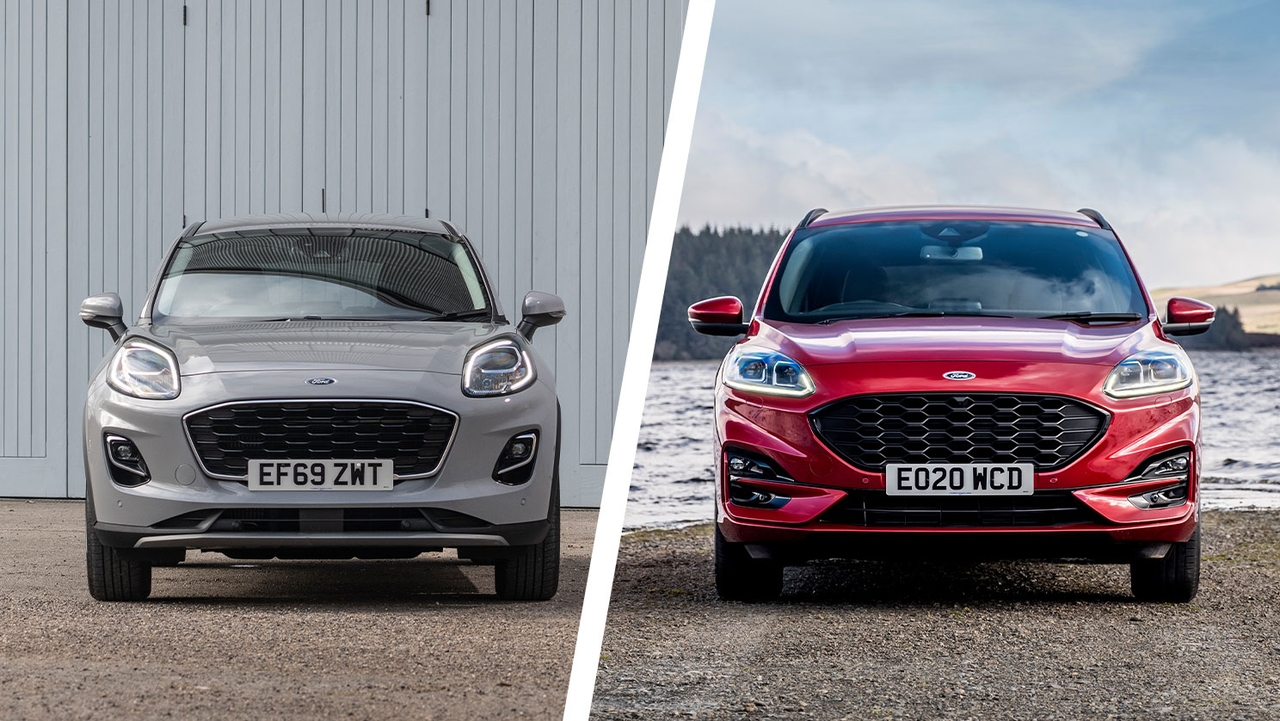
Hailing from the same family tree means plenty of visual similarities between the Puma and the Kuga. Both have oversized headlights sitting either side of a wide grille that, according to our lawyers, bears only a coincidental resemblance to those found on Aston Martin sports cars. The rest of the styling is a little anonymous and generic, lacking the distinctive character lines you'll find on some more stylish rivals. Ford has recently revealed both a facelifted Puma and a facelifted Kuga, but the most meaningful exterior change has been relocating the badge to the front grille so it's really just an incremental update.
In the metal, the Puma stands apart from the Kuga thanks to its overall profile. The car looks lower and more squat, with its body sat within its fat alloy wheels rather than perched on top of them like the Kuga. That said, the Puma's front-end styling is also more exaggerated than the Kuga – fans might like its eye-catching face but we think it looks a bit frog-like from the wrong angles. The Kuga's styling is less divisive but, at the same time, is just a bit dull, so it's probably not a car you'll be buying because it's pulled on your heart strings.
Interior and practicality
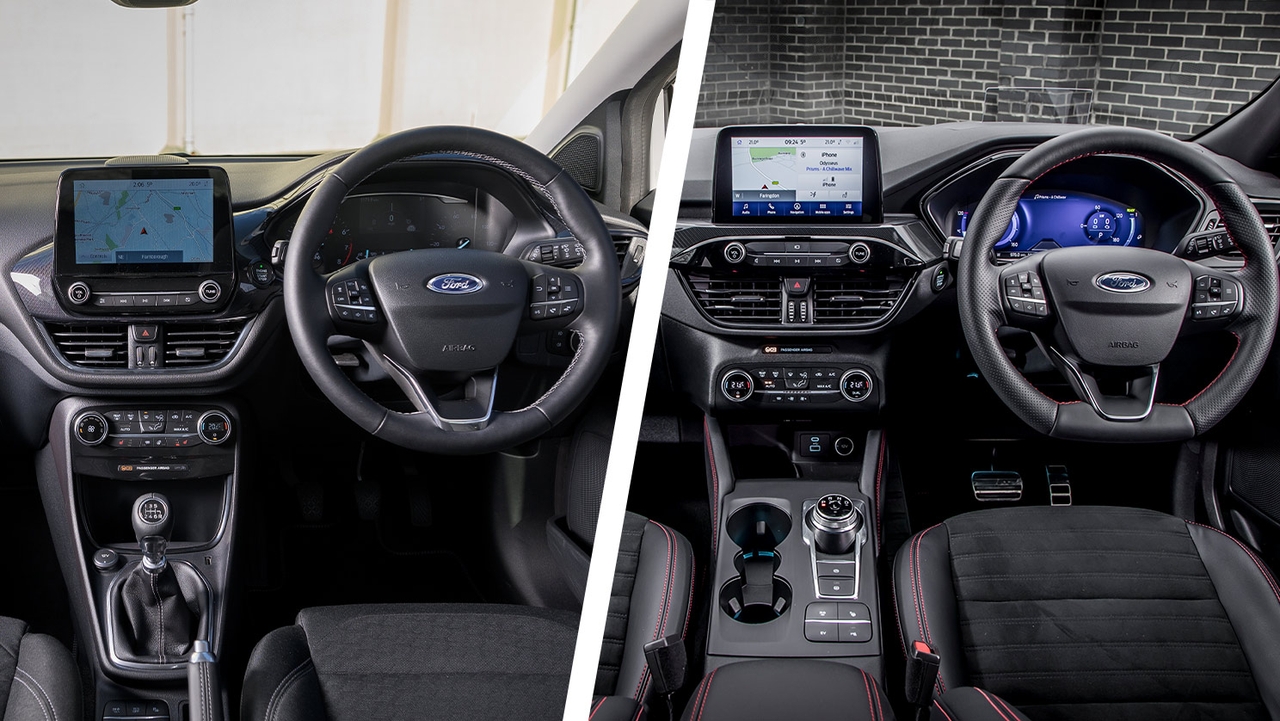
Just like the exterior, Ford's cabin design is functional but falls short of being a feast for the senses. Both cars are styled very similarly inside – you get a central infotainment screen perched atop a handful of shortcut buttons and a volume knob, with physical controls for the heater and A/C below them. We also think both cars overuse black and dark-coloured surfaces throughout the cabin, which means they feel a bit gloomy and uninviting.
The ergonomics are generally excellent, however. As mentioned, key functions are assigned to proper knobs and buttons, which makes them easy to adjust on the go, compared to some rivals that rely too much on their touchscreens. You can go some way to improving the cabin atmosphere by selecting a higher-end trim like Ford's sporty ST-Line option – this brings plush part-leather upholstery with red stitching to add some visual drama.
Considering the Kuga is a bigger car, you expect more cabin space and, thankfully, it delivers. There's substantially more rear-seat space in the Kuga, allowing even very tall adults to stretch out and get comfy. This also makes it the better choice if you're loading kids into their car seats. The Puma, on the other hand, feels tighter in the back and those same tall adults will find their knees and heads brushing the interior trim. The story is flipped somewhat when it comes to boot space, however – in person, the Puma's 456-litre cargo area seems only a fraction smaller than the Kuga's 612-litre space, and also includes a big under-floor area, which the Kuga misses out on.
Engines and performance
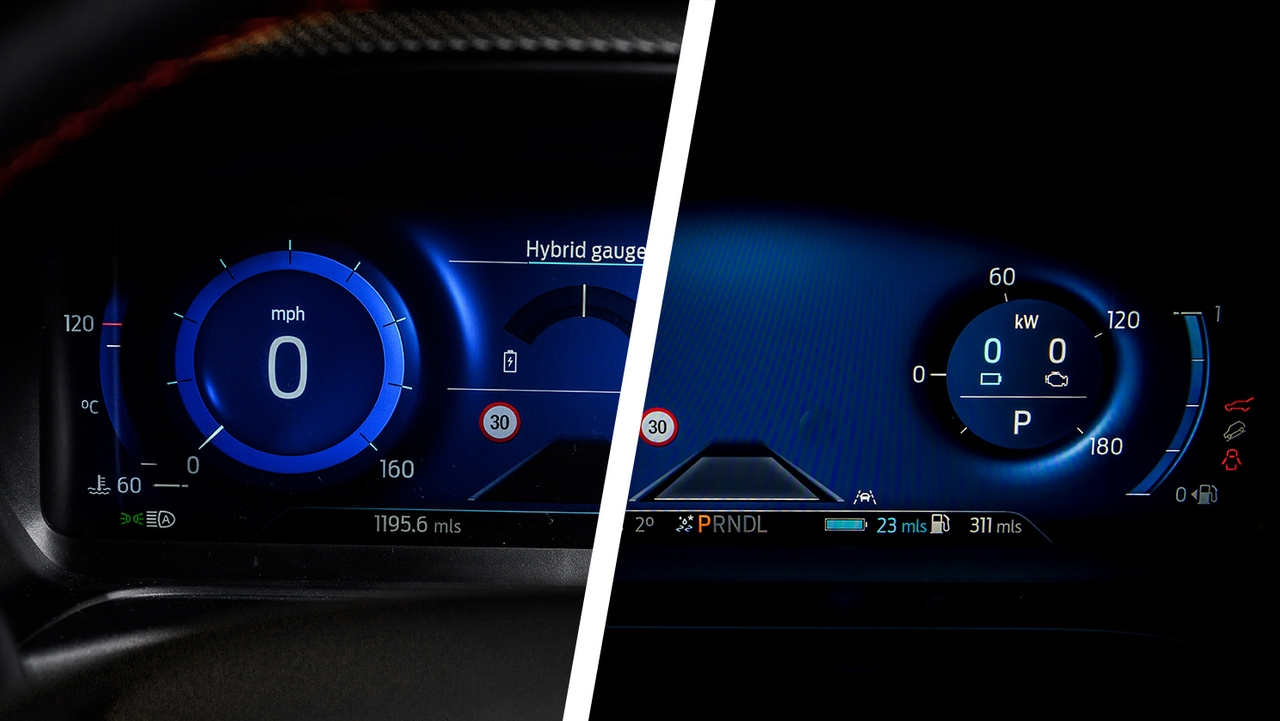
Under the Puma's bonnet you're most likely to find Ford's popular 1.0-litre EcoBoost turbo petrol engine with either 125 or 155hp. Both versions deliver smooth, consistent acceleration without the pronounced vibrations some three-cylinder engines display. Neither feels very fast, however – both in comparison to the Kuga's more powerful engines, and to equivalent engines like the 1.2-litre PureTech turbo found in Peugeot, Vauxhall and Citroen rivals. At least the snappy manual gearchange makes it entertaining to squeeze out every drop of engine power.
The Kuga's the bigger car so gets bigger engines. Recent models are equipped with either 1.5-litre turbo petrol or diesel engines, or a 2.5-litre petrol mated to either a full-hybrid or a plug-in-hybrid setup. Our favourite is the standard 1.5-litre petrol – this makes 150hp with lots of low-down torque and a broad power band that'll whisk you up to motorway speeds effortlessly. It's also much more affordable than either of the hybridised options.
If it's performance you're after, however, you'll want to stick with the Puma which, unlike the Kuga, is available in full-fat ST form. Puma ST cars come with either a manual gearbox and a 1.5-litre petrol boosted to 200hp, or an automatic paired with a 1.0-litre 170hp engine. Both are quick but the manual-equipped version feels like a true hot hatch in SUV form, and makes the most of the Puma's entertaining handling. Sadly the 2024 facelift killed off the more powerful manual version of the Puma ST, leaving only the less powerful automatic.
Driving
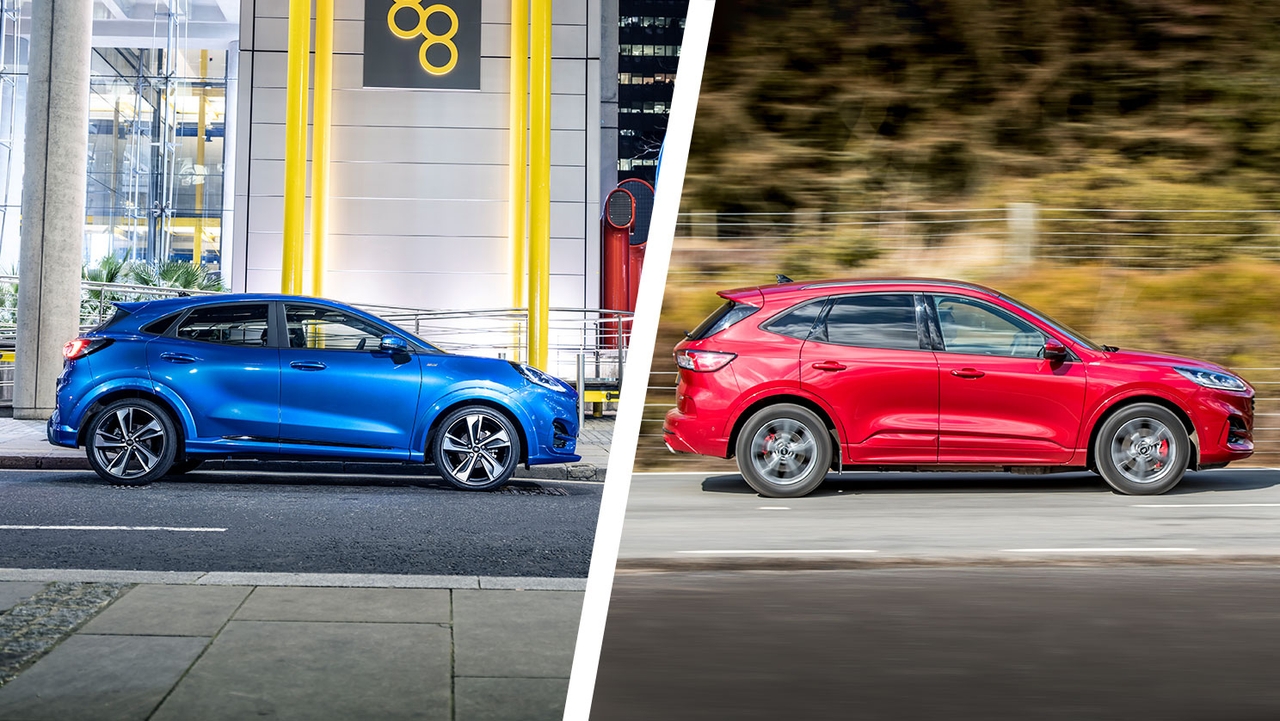
We've come to expect something a bit special when driving a car with a Ford badge, and neither the Puma nor the Kuga disappoints from behind the wheel. You can't argue with the laws of physics, however, so the smaller, lighter Puma is just a hair more fun to drive. It's extremely agile, changing directions like it's performing the quickstep, with superb body control giving you the confidence to push it a little harder into corners. The Puma's also the only car here offered as a high-octane ST model, which amplifies its already impressive handling with enough power to make the front tyres claw at the road surface out of tight corners.
The Kuga is taller and heavier, so can't quite match the Puma's fleet-footed handling. Despite this, it still sits right at the top of its class for driving fun, with beautifully weighted and accurate steering, and well-judged suspension that's never too harsh or too wobbly. In fact, if you're looking for a car to drive everyday, you might appreciate the Kuga's extra degree of softness, which does an even better job of muffling the impact from potholes and speed bumps. Our favourite Kuga engine – the 1.5-litre EcoBoost petrol – is actually a detuned version of the Puma ST's engine and has lots of grunt at all speeds, although it can get a little noisy if you floor it.
Value and reliability
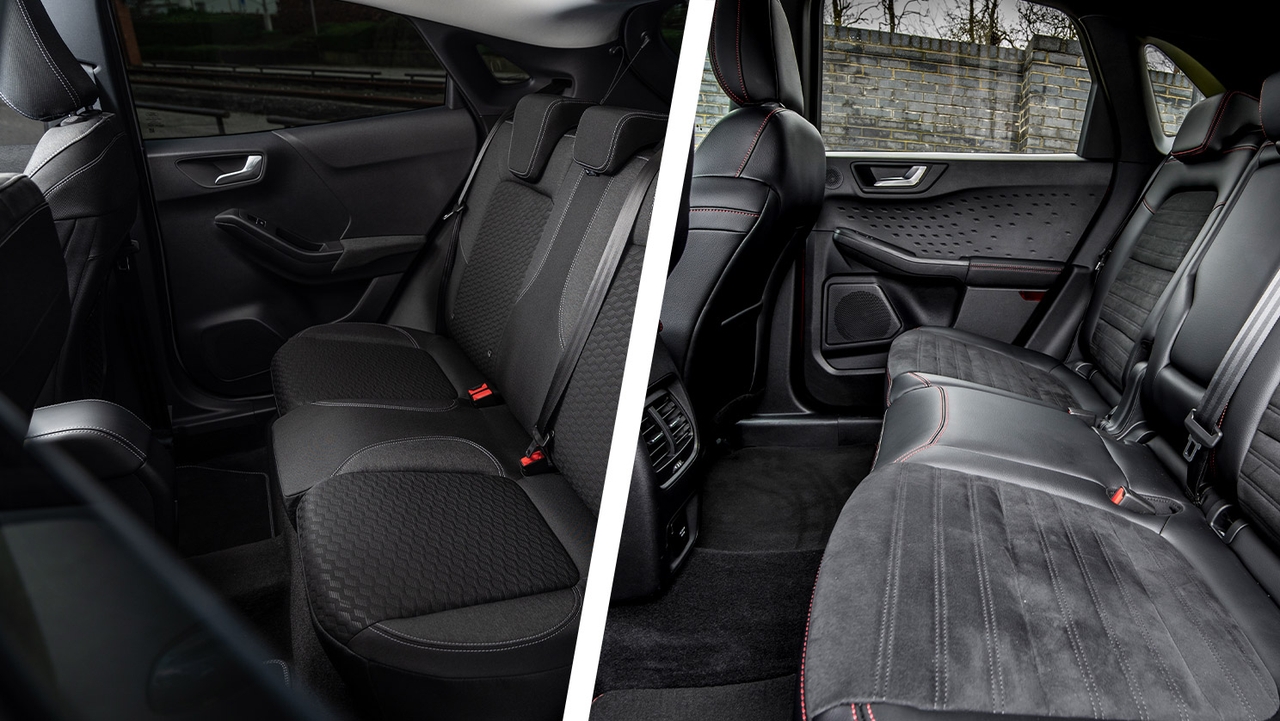
Bought brand new from Ford, the Kuga is more expensive than the Puma by several thousand pounds. That difference shrinks dramatically if you shop used examples of either car, however. Kugas on the used market can end up only a couple of thousand pounds pricier than an equivalent Puma of an equivalent age, spec and condition – and sometimes even closer than that. In practice, this means a budget between £15,000 and £20,000 – or in the region of £250 per month – brings loads of choice across both Puma and Kuga lineups.
Ford typically earns mid-table results for reliability but we've not heard any widespread reports of common problems with the Puma or the Kuga. Keeping on top of scheduled maintenance is the easiest way to make sure your Ford last as long as possible. Regardless of which model you pick, you can take out an extended warranty when you purchase it, either as a new or a used car, to protect yourself from the cost of unexpected mechanical or electrical failures.
Which is best?

If you're shopping for used Pumas and Kugas, your decision should mostly be driven by which car you prefer because prices are remarkably close for pre-owned models. The Puma is the sportier car and will be a little easier to live with in the city thanks to its compact dimensions. Plus, robust used prices suggest the market as a whole thinks the Puma might be the 'cooler' car… we'll let you be the judge of that.
It's hard to argue with the real-world benefits that come with Kuga ownership, however, especially when it might only be a few more pounds per month compared to a Puma. The cabin is noticeably bigger, with much more room for tall rear passengers or kids in child seats, and the driving experience is a little calmer and more refined than the fun-loving but slightly juvenile Puma. If you're a family buyer or you'll often have rear-seat passengers, the Kuga's probably the better choice.
Find out how much you could save over the brand-new list price by buying or financing a used Ford Puma or used Ford Kuga from Motorpoint. For more tempting options, check out our picks for the best family SUVs on sale.

































